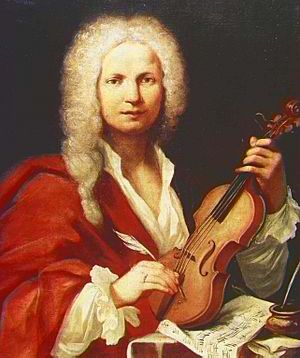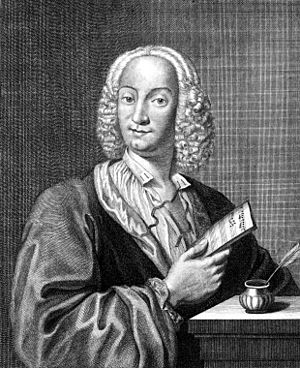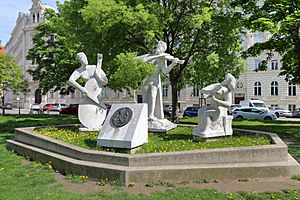Antonio Vivaldi facts for kids
Quick facts for kids
Antonio Vivaldi
|
|
|---|---|

Antonio Vivaldi
|
|
| Born | March 4, 1678 |
| Died | July 28, 1741 (aged 63) Vienna, Austria
|
| Occupation | Composer |
Antonio Vivaldi (born 4 March 1678 in Venice; died 28 July 1741 in Vienna) was a famous Italian composer. He was one of the most important composers of the late Baroque period.
Vivaldi wrote over 400 concertos for different instruments, especially the violin. He also wrote many operas. His most famous work is a group of four violin concertos called “The Four Seasons”. Each concerto describes a season: Spring, Summer, Autumn, and Winter. He is also known for his piccolo compositions, like Il gardellino.
Contents
Early Life and Training
Antonio Lucio Vivaldi was born on 4 March 1678 in Venice. At that time, Venice was the capital of the Venetian Republic.
Vivaldi's parents were Giovanni Battista Vivaldi and Camilla Calicchio. Antonio had five siblings. His father, Giovanni Battista, was a barber who became a professional violinist. He taught young Antonio to play the violin. They even toured Venice together, playing music.
Vivaldi trained to become a priest. Because of his red hair, people called him "il prete rosso", which means "the red priest". He did not work as a priest for very long.
Teaching Music
In 1703, Vivaldi started teaching violin at an orphanage in Venice. This place was called the Pio Ospedale della Pietà, which means "Devout Hospital of Mercy". The girls at this orphanage were chosen because they were very talented musicians.
They gave regular concerts, and Vivaldi wrote music for them to play. He lost this job for a short time between 1709 and 1711 but was hired again. He also took on the extra job of writing sacred music for the girls' choir. He continued teaching until 1716, when he became the head of all music events at the orphanage.
Becoming a Famous Composer
Vivaldi's music quickly became well known. During his break from teaching, he wrote many violin sonatas and concertos. In 1711, a collection of 12 concertos called L'estro armonico op.3 was published. These concertos were for one, two, and four solo violins. This publication made him famous across Europe. Musicians visiting Venice would often come to Vivaldi for lessons.
More of his music was published, making him even more famous. His first opera, Ottone in villa, was performed in 1713. His first oratorio, Juditha Triumphans devicta Holofernis barbaric, was performed by the girls from the Pietà in 1716.
Travels and Later Life
In 1718, Vivaldi left Venice and moved to Mantua. There, he became the director of music for Prince Philip of Hesse-Darmstadt. During this time, he composed his famous "Four Seasons" and several operas.
Around 1721, he went to Rome. He performed for the Pope several times. Even while traveling, he continued to write music for the girls at the Pietà. Over the years, he sent them about 140 concertos. He traveled to many European cities, including Vienna, Verona, and Prague, for his operas to be performed. He often returned to Venice to rehearse his music with the girls.
Death
Even though his music was popular, Vivaldi did not earn a lot of money. As newer musicians and different music styles became popular, it became harder for him to make a living. He moved to Austria to play for royalty. However, when the king died, Vivaldi became poor and could not afford to return home. He died in Vienna on 28 July 1741.
Famous Works
Le quattro stagioni (The Four Seasons) from 1723 is his most famous work. It is part of Il cimento dell'armonia e dell'inventione ("The Contest between Harmony and Invention"). This work describes the feelings and scenes of each of the four seasons. It is a great example of early program music, which tells a story or describes something.
Vivaldi wrote over 500 other concertos.
- About 350 of these are for a solo instrument with strings.
- 230 of these are for the violin.
- Others are for instruments like bassoon, cello, oboe, flute, viola d'amore, recorder, lute, or mandolin.
- About forty concertos are for two instruments and strings.
- About thirty are for three or more instruments and strings.
Besides about 46 operas, Vivaldi also composed a large amount of sacred choral music. Other works include sinfonias, about 90 sonatas, and chamber music.
Vivaldi's Musical Style
Vivaldi's music was very new and creative for his time. He made the structure and rhythm of the concerto more exciting. He also looked for interesting contrasts in harmony and created new melodies and themes.
Johann Sebastian Bach, another very famous composer, was greatly influenced by Vivaldi's concertos and arias. Bach even copied six of Vivaldi's concertos for solo keyboard. He also copied three for organ and one for four harpsichords.
Vivaldi's Legacy
In the early 1900s, a violinist named Fritz Kreisler helped bring Vivaldi's music back into popularity. He played a concerto that he said was by Vivaldi, which made people curious. This led to scholars like Marc Pincherle starting to study Vivaldi's works.
Many of Vivaldi's original music papers were found again. These were bought by the Turin National University Library. This led to a new interest in Vivaldi by many musicians and scholars.
In 1926, researchers found fourteen (later fifteen) bound volumes of Vivaldi's work in a monastery. These had been thought lost during the Napoleonic Wars. The volumes contained 300 concertos, 19 operas, and over 100 vocal works.
The rediscovery of Vivaldi's music in the 20th century was greatly helped by Alfredo Casella. In 1939, he organized a special "Vivaldi Week". During this event, the rediscovered Gloria (RV 589) and l'Olimpiade were performed again. Since World War II, Vivaldi's music has become very popular. Performances using "original instruments" from Vivaldi's time have made his fame grow even more.
Recently, more of Vivaldi's works have been found. These include two psalm settings, Nisi Dominus (RV 803) and Dixit Dominus (RV 807). These were found in 2003 and 2005. One expert, Michael Talbot, called RV 807 "arguably the best non-operatic work from Vivaldi's pen to come to light since the 1920s". Vivaldi's 1730 opera Argippo (RV 697), which was thought to be lost, was found again in 2006. It was performed again in 2008 at Prague Castle, for the first time since 1730.
Modern stories about Vivaldi's life include:
- A 2005 radio play called The Angel and the Red Priest.
- Films like Red Venice (1989).
- Antonio Vivaldi, a Prince in Venice (2006).
- Vivaldi, the Red Priest (2009), which is loosely based on his life as a priest and composer.
Images for kids
-
Caricature by P. L. Ghezzi, Rome (1723)
-
Allée Vivaldi, Paris. Named after Antonio Vivaldi.
See also
 In Spanish: Antonio Vivaldi para niños
In Spanish: Antonio Vivaldi para niños










